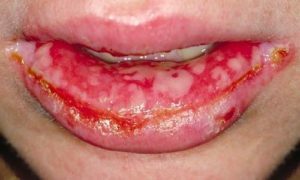 Pemphigus is a very serious dermatological disease that can lead to serious consequences and complications. Especially dangerous is the development of pemphigus in newborn babies, in which case even death is not excluded.
Pemphigus is a very serious dermatological disease that can lead to serious consequences and complications. Especially dangerous is the development of pemphigus in newborn babies, in which case even death is not excluded.
People of different ages are affected by this disease, however, in most cases it is observed in adults 40-60 years old. Children suffer from this disease very rarely. Since the disease is an autoimmune pathology, it is difficult to treat and is chronic.
The disease is expressed by the appearance on the skin and mucous membrane of the bubbles, filled with exudate. Neoplasms merge with each other and quickly spread throughout the body.
content
- causes of disease
- Types pemphigus
- symptomatology of the disease
- Specificity pemphigus of the mouth cavity mucous
- Diagnosis and severity
- disease What are methods of treatment and prophylaxis
- Pharmacotherapy
- Local treatment
- prevention methods
- Possible complications and consequences
Causes
diseaseThere are no specific reasons for the occurrence of bladderwort, but the provoking factors that influence the timesItie disease, namely:
- genetic predisposition;
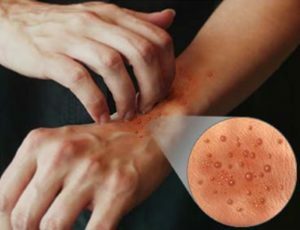
- viral infections;
- harmful working conditions;
- allergic reaction to certain types of products, metals, chemical reagents;
- disturbance of metabolic processes in the body;
- endocrine diseases;
- long-term use of certain types of medications.
The autoimmune cause of the origin of the disease is also considered. In children, the cause of the disease can become viruses and bacteria, among which the main is Staphylococcus aureus.
Types of pemphigus
First of all, the pathological process of the disease is classified into:
- true pemphigus( acantholic);
- benign pemphigus( non-acantholic).
The true pemphigus, depending on the manifestation of the pathological process, is classified into the following subspecies:
- Vulgar( ordinary) pemphigus .The most common type. Characterized by the appearance on the skin of blisters without signs of inflammation.
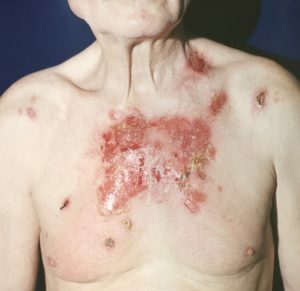 If there is no proper treatment - there is a rapid spread of vesicles throughout the body. When the state of the disease is neglected, death is not rare.
If there is no proper treatment - there is a rapid spread of vesicles throughout the body. When the state of the disease is neglected, death is not rare. - Erythematous, is also a seborrheic pemphigus. It is difficult to treat, characterized by the appearance of red spots with dense crusts.
- Sheet .Pemphigus is characterized by the appearance of flat bubbles and a multitude of peeling crusts that create the effect of leaves( photo on the right).
- Brazilian .This pathology is common in Brazil. As a rule, all family members suffer. Both children and elderly people are exposed.
Symptomatic of the disease
Regardless of the type, the disease has similar symptoms. The disease develops very rapidly, therefore at the first manifestations it is necessary to immediately consult a doctor.
For pemphigus is characterized by undulating course, but rapid spread of foci and progressing course. There are remissions of varying degrees and duration.
The pimple in the mouth manifests itself in ulcers not immediately, a few days after infection. The first symptoms are malaise, fever and redness of the throat. In such cases, the disease is classified as a simple cold, and the treatment is not properly administered.
Only the manifestation of ulcers and vesicles in the oral cavity indicates the development of the pathological process. In this case, the patient has an unpleasant smell from the mouth.
Specificity of pancreas of the oral mucosa
According to medical dental statistics, the mucous membrane of the oral cavity is most often affected by vulgar pemphigus. It is this type of disease that first affects the mucous membrane of the mouth and larynx, and then spreads to the face and body.
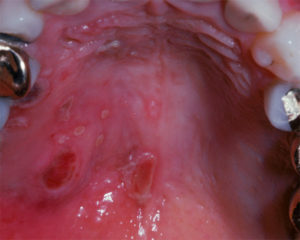 The spreading of the blisters on the skin can begin several months after the appearance of the first bubbles in the mouth, and may appear immediately, after one or two days.
The spreading of the blisters on the skin can begin several months after the appearance of the first bubbles in the mouth, and may appear immediately, after one or two days.
With strong immunity, timely and competent treatment, the spread of blisters on the skin may not start.
Emerging on mucous erosion does not bleed, but due to constant friction and touching food quickly open.
In this case, when examining the oral cavity, it is rarely possible to detect the presence of blisters. Oval or round sores remain on the place of the blisters, which heal for a long time. As a rule, erosions of the oral mucosa heal without scars.
However, without proper treatment, erosions do not heal, but, on the contrary, increase and merge into larger affected areas. Most often, ulcers are localized on the inner side of the cheeks, the lower surface of the tongue and the sky. On ulcers there is a white coating, which is easily removed by the dentist with a medical spatula.
Painful sensations in the patient are quite strong, especially intense when talking and eating. Ulcers quickly become infected. In the case of non-sanation of the oral cavity, the probability of infection of erosions and the addition of additional fungal and viral infections increases. A dental check is required.
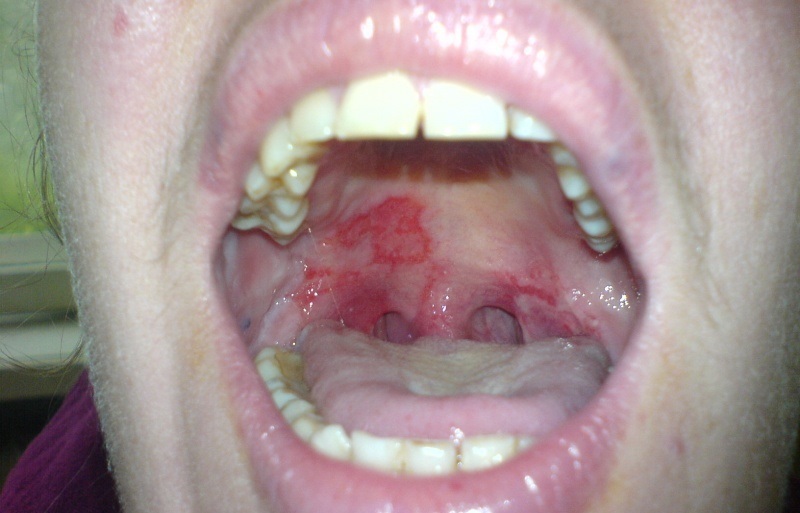
With pemphigus in the mouth, the patient often suffers from stomatitis. In addition to the mouth, the disease can spread to other organs, covered with a mucous membrane: the larynx, the digestive tract and others.
Diagnosis and severity of the disease
Since the symptomatology at the initial stage of the disease development is similar to many other dermatological diseases, it is necessary to conduct a comprehensive examination to accurately determine the diagnosis, namely:
- examination of the patient - the nature of the lesion and the site of localization;
- study of anamnesis of the patient and the presence of concomitant diseases;
- conducting a sample of Nikolsky, which will distinguish pemphigus from similar pathological processes;
- carrying out histological and cytological studies;
- use of immunological methods that confirm or disprove the autoimmune nature of the disease.
Disease as the development and spread of the vesicles is characterized by varying degrees of severity: 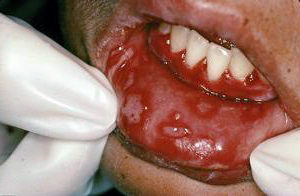
- Light .The pathological process appears on mucous or skin integuments gradually with a minimum number of foci.
- Average .With a moderate course of the disease, the spread of blisters on the skin and mucous membrane is increased in an increased amount.
- Heavy .Most of the skin and mouth are affected. Ulcers merge into large foci. Complications and pathologies begin.
What are the methods of treatment and prevention
Without proper treatment, the outcome of the disease is unfavorable. Practically in two years at the started state of the disease there can be a lethal outcome.
The treatment process is rather complicated and time-consuming. Because of the rapid development of the disease, the functioning of many organs is disrupted, which can lead to the appearance of additional diseases.
Medical treatment
During the period of taking any drug should be observed at the doctor and monitor blood pressure and sugar level, regularly handing out laboratory tests of blood and urine.
Medication therapy includes the following drugs:
- antibiotics - used in purulent infectious processes, contribute to the death of the pathogen;
- corticosteroid preparations - help reduce the manifestation and speed of the spread of the vesicles along the skin;
- cytostatics - are used to reduce the possibility of developing complications.
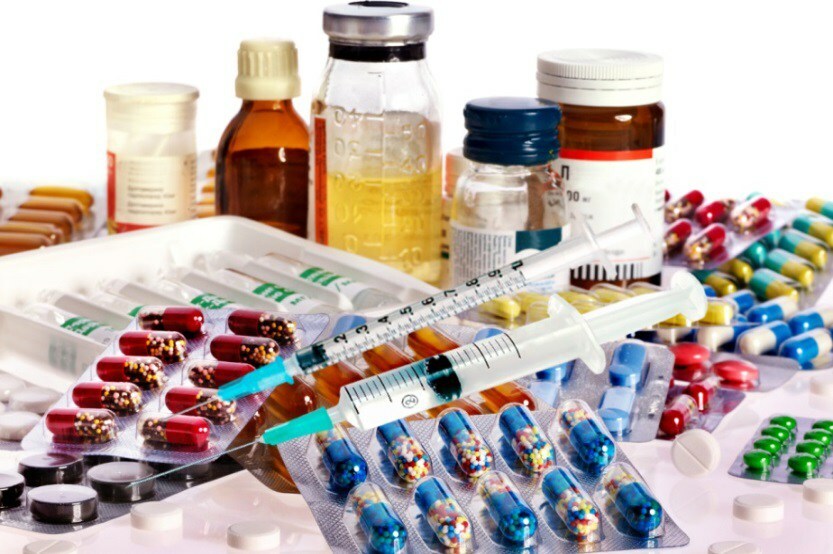
The dose of the drug and the duration of the intake are selected by the doctor, based on the severity of the condition of the disease. After the course of treatment, the patient may be prescribed corticosteroid drugs to prevent relapse. Many drugs have side effects.
Local treatment
Local therapy plays only an auxiliary role in drug treatment. During the treatment of pancreatic mucosa in the oral cavity as a local therapy, it is advisable to follow the following recommendations:
- to timely sanitize the oral cavity;
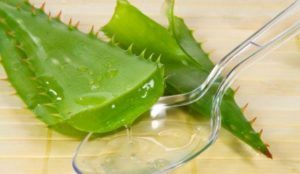
- Before and after eating, rinse the affected oral mucosa with disinfectant and deodorizing agents, antibacterial solutions based on chamomile and St. John's wort;
- bubbles can be treated with aloe juice, tincture of plantain, calendula and celandine;
- apply lotions from chamomile broth;
- juice of nettle leaves to apply to damaged covers;
- to exclude from the diet acute and salty foods.
Local treatment and folk remedies will help only temporarily to reduce the symptoms of the disease and reduce pain, but will not cure the disease.
Methods of prevention
Patients who have been diagnosed with this disease should be registered with a dermatologist. The disease requires constant monitoring of the doctor and adherence to preventive measures:
- observe a gentle mode of work and moderate physical activity;
- to abandon bad habits;
- Avoid exposure to sunlight on the skin;
- to avoid stressful situations;
- keep track of the cleanliness of bed and underwear.
In the case of an advanced form of pemphigus and the lack of timely and competent treatment, the prognosis of the disease is unfavorable. Various infections can join, as a result of which the patient can die from complications.
Possible complications and consequences of
In the case of a complicated course of the disease, a large area of skin or mucous membrane is affected, ulcerous erosions are formed, which are covered with crusts during healing.
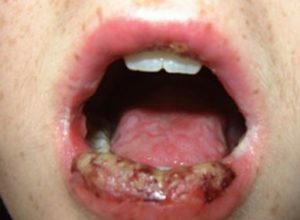
The most dangerous complication is the infection of damaged skin or the attachment of secondary infections.
For children, the complications and consequences of pemphigus carry a big threat of further development. The disease adversely affects the immune system of the child and his health.
The most severe consequences are due to a lack of timely diagnosis and the necessary treatment, namely:
- the general condition of the patient worsens severely, and the protective immune system decreases;
- rapidly spreading bubbles of varying density, which causes severe pain and inconvenience to the patient;
- formed dense crusts of large area, resembling in appearance lichen;
- develop serious secondary diseases, for example, heart failure, brain edema and many others.
Any form of pemphigus is a dangerous and serious pathology, which can not be started. The disease develops very quickly, so any delay is fraught with serious consequences and complications that can lead to death. At the first symptoms of the disease you need to urgently undergo a test and monitor the course of the disease.
